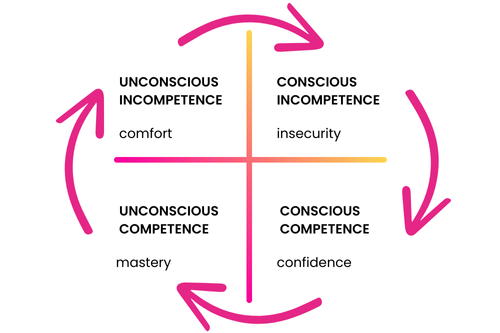
Every day, often without even realizing it, we learn new skills, such as learning to use a new application, or we improve those we already possess, such as learning an excel formula that saves us time.
Human beings have an innate impulse to evolve, adapt and make sense of the world around us. This inherent curiosity drives us to hone our skills and seek new solutions through knowledge. our desire to learn and adapt shapes both who we are individually and how we relate and act in the social and global context.
For certain skills to truly become part of our lives, we must use them regularly to internalize learning and turn it into habitual and spontaneous behavior.
What are the Four Stages of Learning?
Understanding the Four Stages of Learning-also known as the Four Stages of Competence-can help us approach personal development in a more structured and meaningful way.
The Four Stages of Learning model first appeared in the text Management of Training Programs by DePhillips, Berliner, and Cribbin of New York University. In 1969, Broadwell described the model as “the four levels of teaching” in an article published in February 1969.
In the 1970s, Burch adopted the model and renamed it “the four stages of learning a new skill.”
The model has stood the test of time, supported by modern neuroscience that shows how the brain forms new neural connections during learning. Today it remains a cornerstone for understanding how skills are acquired, emphasizing the importance of self-awareness and intentional reflection for effective learning.
In our learning journey, we go through four distinct stages: unconscious incompetence, conscious incompetence, conscious competence and unconscious competence. Each stage presents unique challenges and rewards, strengthening our potential.

1. Unconscious Incompetence: You don’t know what you don’t know.
The first stage of learning is stage zero, We are in a state of unconsciousness with respect to what we need, can learn, or improve.
We don’t know what we don’t know. We don’t know something exists. We’re happy in our comfort zone without looking outside. This can lead to complacency and a lack of motivation to change as there is no perceived need to change .
To progress to the next stage, we must first recognize that there is a gap in our knowledge or skills.
It takes external feedback from someone or something, a reflection on goals, or a recognition that circumstances are changing to ignite the process.
For example; you might continually manually input data in a system because that is the only way you know how.
TIP: Be open to feedback and personal reflection. Look for areas where you could improve and don’t be afraid to take risks and try new things.
2. Conscious Incompetence: Know Yourself.
The second stage of learning is conscious incompetence. There comes the famous “aha!”-moment when you realize some shortcomings. You know something exists, but you don’t know how it works, or how to do it. This stage of awareness brings with it frustration, but it is the basis on which to set up growth. This is where the motivation to seek resources, tools or training to improve your skills arises.
For example: You’re still inputting data manually and your colleague, who is already taking a coffee break, says, “Hey, aren’t you done? I just bulk-uploaded mine” and, if you’re curious and open to feedback, the learning bug takes over. You start to look for a new solution through learning.
TIP: Set reasonable goals and proceed step by step, breaking the skill down into small steps. Value every achievement, no matter how small, and give yourself time to learn and improve.
3. Conscious Competence: Practice Makes Perfect
The third stage of learning is conscious competence. In this stage we now have the technical skills to perform a task, but execution requires focused effort to get the desired results. It is the stage of experimentation where we may make mistakes, we are still learning and our progress.
Now you are able to perform the task, but it requires concentration and It is like driving a car for the first few times: you are hyper-aware of every movement, from turning the steering wheel to checking the mirrors. Or when learning a new language, you know the grammar rules, but they might not come to mind when speaking. The effort pays off as the skills solidify and you gain confidence.
The length of this phase depends on how quickly we can internalize the skill into our mental and physical patterns.
For example: You’ve discovered CSV, JSON, XML and how to create them, but the csv didn’t work the first time, so you had to format it with commas and try again, then you mismapped name, last name into full name so you keep going til you get it right.
TIP: Spend time practicing. Apply what you have learned in different contexts and take advantage of every opportunity to get feedback so you can refine your technique and solidify your confidence.
4. Unconscious Competence: the Zone
The final stage of learning is unconscious competence. In this stage, and we are able to perform the new skill without conscious effort or attention. It’s second nature.
The skill is no longer new; it is now a natural act, a routine that we perform spontaneously and effortlessly, as if it were part of our being. This stage represents mastery and can be a very rewarding experience.
You have practiced so much that you no longer have to think about each step. Athletes call this state “the zone” or “state of grace” when everything comes easy to us, performance flows and results are resounding. This is where we go back into our comfort zone.
For example: you’re busy transforming files and quickly bulk uploading them with ease.
TIP: Keep an open and curious mindset. The possibilities for growth and improvement are endless; take advantage of any opportunity for training and upgrading.
Learning in the Tech Era
In the age of technology, this fourth learning phase can quickly becomes again phase 1.
For example: Using your new natural skills, you’re in the zone, quickly uploading files… but in your new unconscious Incompetence. ….as your colleague comes along while you’re uploading and says, “are you still bulk-uploading? I just integrated those systems.” and the learning cycle starts again 🙂
Each of the 4 learning steps to achieve competency in a new skill. Stay curious, embrace the process, and celebrate the small successes, and remember: mastery takes practice.
Let’s keep learning, one step at a time.


